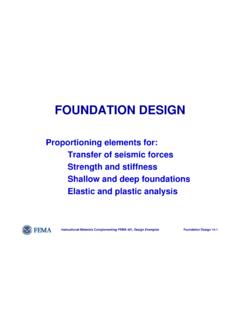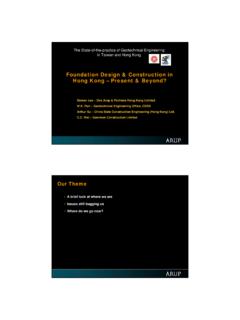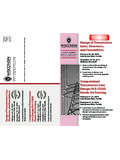Transcription of Practical Application of Geotechnical Limit Analysis in ...
1 Jan/Feb 2009 Seminar: Geotechnical Stability Analysis to Eurocode 720/05/2008 LimitState:GEO launch & technology briefing -ICE London Application of Geotechnical Limit Analysis in Limit State DesignDr Colin SmithUniversity of Sheffield, UKDirector, LimitStateLtd UKContents Ultimate Limit State design to Eurocode 7 Factors of safety Use of Partial Factors Eurocode 7 : advantages and disadvantages Practical examples (II) Limit State DesignSpecific Objectives At the end of this lecture , delegates should be aware of: the core principles underlying Limit State design the implementation of Limit State design as exemplified by Eurocode7 the use of Limit State design with computational Limit Analysis challenges and advantages of Limit State DesignJan/Feb 2009 Seminar: Geotechnical Stability Analysis to Eurocode 720/05/2008 LimitState:GEO launch & technology briefing -ICE London 31/07 state Analysis / designWhat is Limit state Analysis / design ?
2 Limit states are states beyond which the structure no longer satisfies the relevant design criteria focus on what might go wrong ultimate Limit state (ULS)and serviceability Limit state (SLS) Not directly related to specific Analysis methodsWhat is Limit state Analysis / design ? [2]* An understanding of Limit state design can be obtained by contrasting it with working state design : Working state design : Analyse the expected, working state, then apply margins of safety Limit state design : Analyse the unexpected states at which the structure has reached an unacceptable Limit Make sure the Limit states are unrealistic (or at least unlikely) *Brian Simpson, ArupThe ultimate Limit state According to EC 0 ( Basis of structural design ).
3 [Serious consequences of failure mean this must be rendered a remote possibility]Implementation in practiceConsideractions (loads)andresistances ( resistance available at collapse)Implementation in practice [2]Partial factors are applied to Actions and ResistancesProbability of occurrenceParameter we take the resistance at the footing/soil interface?Or in the soil? [2]Jan/Feb 2009 Seminar: Geotechnical Stability Analysis to Eurocode 731/07 of Limit State design in Eurocode 7 Eurocode 7 has been under development since 1980. Use of Eurocode 7 will be mandatory in the UK in 2010. Original draft had 1 design Approach (DA) Now has 3 different design Approaches.
4 Individual countries are free to adopt one or more approaches for national useEurocode 7 Eurocode 7 moves away from: working stresses overall factors of safetyto: Limit state design approach partial factors unified approachEurocode 7It introduces a range of separate checks: Ultimate Limit States (ULS) Serviceability Limit States (SLS)Eurocode 7 EQU : loss of equilibriumSTR : failure of the structureGEO : failure of the groundUPL : failure by upliftHYD : hydraulic heaveExisting codesExisting codes often combine SLSand ULS:Advantages: Simple Only one calculation requiredDisadvantages: Not necessarily transparent, Safety factors typically only applicable for a specific subset of parametersIn the UK the checks against failure in the ground (GEO) and in the structure (STR) must be checked using design Approach 1 (DA1) which requires that two checks are performed: design combination 1 (DA1/1) design combination 2 (DA1/2)Eurocode 7 Different factors are applied if loads (Actions) are: Permanent Variable AccidentalDifferent factors are applied if loads (Actions) are.
5 Favourable assist or resist collapse (this may not be clear at outset)Loads (Actions)EC7 DA1/1EC7 DA1/2 Conventional bearing capacityBS8002 (Retaining walls)Permanent unfavourable unfavourable ' ' FactorsQuick GuideJan/Feb 2009 Seminar: Geotechnical Stability Analysis to Eurocode 720/05/2008 LimitState:GEO launch & technology briefing -ICE London 31/07 7 Example: Foundation DesignExample foundation design Simple design case: Footing on undrained(clay soil)Examine: Conventional design approach design to Eurocode7 Example foundation design [2]Terzaghi s bearing capacity equation:cu= 70 kN/m2 = 20 kN/m3q= 10 kN/m2 *W = 40 kN/mB = 2m BNqNcNBRqc21/ VWqqRB*Assume q is a permanent loadFor the undrained case:qcBRu )2(/ Example foundation design [3] design to Eurocode7 Eurocode7 requires a change in conceptual approach.
6 Instead of finding a collapse load and factoring it, it is necessary to define ActionsandResistancesin the problem and ensure that Actions ResistancesTo ensure reliability of the design , Partial factorsare applied to the actions and resistances/material foundation design [4]The actions (E) driving the footing to collapse are:cu= 70 kN/m2 = 20 kN/m3q= 10 kN/m2W = 40 kN/mB = 2mVWqqR Foundation load V Foundation self weight WExample foundation design [5]The Resistance R opposing collapse of the footing is provided by:cu= 70 kN/m2 = 20 kN/m3q= 10 kN/m2W = 40 kN/mB = 2mVWqqR Soil resistance R (applied at base of footing)Example foundation design [6]cu= 70 kN/m2 = 20 kN/m3q= 10 kN/m2W = 40 kN/mB = 2mVWqqConventionalDA1/1DA1/2 DesignActions(Ed)E=V+WV+ (V+40) (V+40) design Resistance (Rd)R=B( +q)Rd(kN/m)247740534Ed<RdV 207 kN/mV 508 kN/mV 494 ) (2 ) (2 ) (2 Eurocode 7 Comments: The most critical case must be taken in Eurocode 7.
7 In this case maximum permissible load on the foundation is V = 494 kN/m (in design Combination 2) This value is significantly higher than that allowed by the conventional design approach (V = 207 kN/m) Why?Eurocode 7 [2] Eurocode7 presents a significant change in philosophy compared to most previous codes. The preceding calculations are reliability based and ensure that the probability of collapse at the ULS is very low. The calculation says nothing about the SLS which must be addressed by a separate calculation. The = 3 method implicitly addressed both SLS and ULS. One reason can be related to the non-linearity of some Limit Analysis calculations when checking Geotechnical the bearing capacity of a footing sitting on a cohesionless soil: The exact solution is given by: V/B = BN Where N must be computed numerically.
8 Why two calculations? VWhy two calculations? [2] N 25 23450 743 Values of N are highly sensitive to the value of :Why two calculations? [3]Example results(unfactored) for B = 2m, = 16 kN/m3: V(kN/m)V/275040 two calculations? [4]Active soil thrust for a smooth wall P is given by: P,212 HKPa H sin1 sin1aK Ka(DA1/1)Ka(DA1/2)ratio30 does not become critical until '>45 . However if soil strength is relevant in other parts of the problem ( base sliding) then DA1/2 typically 2009 Seminar: Geotechnical Stability Analysis to Eurocode 720/05/2008 LimitState:GEO launch & technology briefing -ICE London 31/07 of Safety and overdesign factorsFactors of SafetyMany different definitions of factors of safetyare used in Geotechnical engineering.
9 Three in common usage are listed below: on load. on material strength. defined as ratio of resisting forces (or moments) to disturbing forces (or moments).The calculation process used to determine each of these factors for any given problemwill in general result in a different failure mechanism, and a different numerical factor. Each FoS must therefore be interpreted according to its Ultimate Limit State In general any given design is inherently stable and is nowhere near to its ultimate Limit state. In order to undertake a ULS Analysis it is necessary to drive the system to collapse by some means. This can be done implicitly or explicitly.
10 In many conventional analyses the process istypically implicit. In a general numerical Analysis it must be done explicitly. Driving the system to ULST here are three general ways to drive a system to ULS corresponding to the three FoS definitions previously mentioned: an existing load in the the soil an additional load in the systemComputational Limit Analysis (including LimitState:GEO) solves problems using Method 1. However it can be straightforwardly programmed to find any of the other two types of Factors of Safety. Method 1 Question:how much bigger does the load need to be to cause collapse, or, by what factor adoes the load need to be increased to cause collapse:This factor ais the adequacy * aMethod 2 Question:how much weaker does the soil need to be under the design load to cause collapse, or, by what factor Fdoes the soil strength need to be reduced to cause collapse:This factor Fis the factor of safety on , tan /FQuestion.






